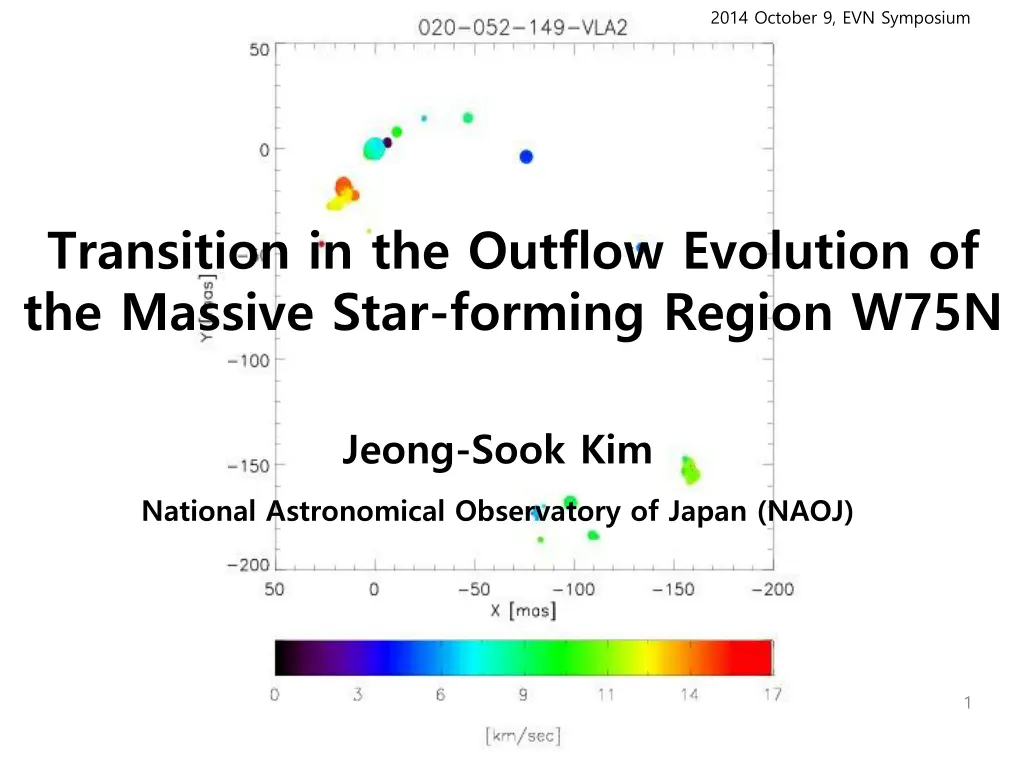
Outflow Evolution in Massive Star-Forming Region W75N Studies
"Explore the transition in outflow evolution of the massive star-forming region W75N through research presented at the EVN Symposium. Debates on scenarios of star formation mechanisms are discussed along with the distribution of H2O masers from VLBA and VERA observations, showing the evolution of outflows over time. Discover insights into the evolution from wind-like to more bipolar-like outflows in this intriguing astronomical study."
Download Presentation

Please find below an Image/Link to download the presentation.
The content on the website is provided AS IS for your information and personal use only. It may not be sold, licensed, or shared on other websites without obtaining consent from the author. If you encounter any issues during the download, it is possible that the publisher has removed the file from their server.
You are allowed to download the files provided on this website for personal or commercial use, subject to the condition that they are used lawfully. All files are the property of their respective owners.
The content on the website is provided AS IS for your information and personal use only. It may not be sold, licensed, or shared on other websites without obtaining consent from the author.
E N D
Presentation Transcript
2014 October 9, EVN Symposium Transition in the Outflow Evolution of the Massive Star-forming Region W75N Jeong-Sook Kim National Astronomical Observatory of Japan (NAOJ) 1
Massive Star Formation & Outflow Evolution The evolution of outflow associated with massive star formation is still in debate, that is, In Scenario 1: [star formation through accretion disk] the well-collimated outflow occur first before the less collimated outflow forms with the build-up of HII region (Beuther et al. 2005) Scenario 2: [gas ejection vis MHD]: However, in recent MHD simulations, wind-like outflow could occur first depending on magnetic filed strength. (Seifried et al. 2011, 2012)
Distribution of H2O Maser in W75N -1999 (VLBA) (Torrelles et al. 2003) In VLA1, the maser distribution is a well collimated jet like outflow. VLA1 In VLA2, the maser shell with 130 AU shows a less- collimated and wind-like outflow. VLA2
Distribution of H2O Maser in W75N - 2005(VLBA) Surcis et al. (2011) VLA1 VLA2 Six years later, Surcis et al. (2011) found that the wind-like outflow in VLA 2 is still expanding.
VERA Mizusawa 20m (& 10m) Correlation Center at Mitaka/NAOJ Mizusawa Iriki 20m Ulsan Seoul KVN Jeju Iriki VERA Ogasawara Ishigaji-jima 20m Ogasawara 20m Ishigaki And, two years after Surcis et al. s observation, we observed W75N with VERA.
Distribution of H2O Masers in W75N -2007 (VERA) Kim et al (2013) We observed water masers three epochs of VLA 1 and VLA 2 regions in 2007 January, February and May.
H2O Masers in VLA 2 Region: Elliptical Model Fit Expanding Shell Ellipses Epoch a b b/a PA ( ) (mas) (mas) T99 1999.3 71 1 64 1 ~0.90 5 3 S05 2005.9 97 3 93 2 ~0.96 15 45 K07 2007.2 111 1 68 1 ~0.61 45 1 We compared ours to previous 1999 and 2005 observation. To our surprise, the shell has become more eccentric, giving us a hint that the outflow has evolved from wind-like to more bipolar-like.
H2O Masers in VLA 2 Region: Elliptical Model Fit Expanding Shell Ellipses Epoch Expansion Velocity (mas /yr) (km/s) T99 1999.3 S05 2005.9 T99 S05: 3.9 0.8 T99 S05: 37 8 K07 2007.2 S05 K07: 10.8 3.1 S05 K07: 102 29 T99 K07: 5.1 0.2 T05 K07: 48 2 Furthermore, based on the major axis, the expansion velocity of the shell is increased. This means the shell has been accelerated !
Comparison to New MHD Model (Seifried et al. 2012) First, In the very early stage, poorly collimated sphere-like outflows are typical, with sub- Keplerian disks and strong magnetic fields. Second, outflow collimation will quickly increase due to the development of well-collimated, fast jets coupled to the build-up of Keplerian disks with a few times weak magnetic fields. [1] [2] Fast, jet-like signature development of a inner, fast component Slow, wind- like slow expansion outer, slowly expanding component [3] [Kim et al. 2013] Third, for models with a intermediate magnetic fields , there are outflows consisting of two distinct components: (1) an outer, slowly expanding component and (2) an inner, fast component, and the transition is continuous. Their MHD results are consistent with our observational result, that is, in the very early stage of massive star formation, the less-collimated outflow would appear before the collimated outflow.
Polarization observation in W75N - 2012 Surcis et al (2014) 1999 2005 2007 2012 VLA1 orientation of magnetic field (with errors) measured with polarization VLA2 1.3 cm continuum contour map: water (blue) & OH maser(red). [Torrelles et al. 1997] linear polarization vector In the VLBI observation in 2012, Surcis et al. found that: * The maser shell outflow is still expanding and elongated similar to 2007. * The magnetic field orientation has been changed to the new direction of the major axis, aligned with that in VLA1 along with the direction of the large- scale molecular outflow.
Polarization observation in W75N - 2005 vs. 2012 Surcis et al (2014) The magnetic field in 2012 is one third of the magnetic field measured in 2005. It is consistent observational results with the recent simulation of Seifried et al (2012). we are seeing such a dramatic evolution in real time, for the first time.
Follow-up observations First, To trace of morphology for water maser in VLA2, Three time observations on April to May by using VERA in 2014 was carried out. We have a observational plan by using VERA or KAVA in 2015. Second, to monitoring of polarization for W75N, EVN proposal has been accepted for the polarization mode over 6 years, 4 epochs spaced by 2 years. And, the 1st one was recently performed on June 17, 2014.
